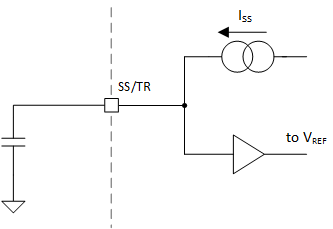JAJSOF9A october 2022 – march 2023 TPS62992-Q1
PRODUCTION DATA
- 1 特長
- 2 アプリケーション
- 3 概要
- 4 Revision History
- 5 Device Comparison Table
- 6 Pin Configuration and Functions
- 7 Specifications
-
8 Detailed Description
- 8.1 Overview
- 8.2 Functional Block Diagram
- 8.3
Feature Description
- 8.3.1 Mode Selection and Device Configuration MODE/S-CONF
- 8.3.2 Adjustable VO Operation (External Voltage Divider)
- 8.3.3 Selectable VO Operation (VSET and Internal Voltage Divider)
- 8.3.4 Soft Start and Tracking (SS/TR)
- 8.3.5 Smart Enable with Precise Threshold
- 8.3.6 Power Good (PG)
- 8.3.7 Output Discharge Function
- 8.3.8 Undervoltage Lockout (UVLO)
- 8.3.9 Current Limit and Short-Circuit Protection
- 8.3.10 High Temperature Specifications
- 8.3.11 Thermal Shutdown
- 8.4 Device Functional Modes
-
9 Application and Implementation
- 9.1 Application Information
- 9.2 Typical Application with Adjustable Output Voltage
- 9.3 Typical Application with Selectable VOUT using VSET
- 9.4 System Examples
- 9.5 Power Supply Recommendations
- 9.6 Layout
- 10Device and Documentation Support
- 11Mechanical, Packaging, and Orderable Information
9.2.2.3.3.3 Soft-Start Capacitor
A capacitor connected between SS/TR pin and GND allows a user-programmable start-up slope of the output voltage.
 Figure 9-2 Soft-Start Operation Simplified Schematic
Figure 9-2 Soft-Start Operation Simplified SchematicAn internal constant current source is provided to charge the external capacitance. The capacitor required for a given soft-start ramp time is given by:
Equation 18.
where
- CSS is the capacitance required at the SS/TR pin.
- TSS is the desired soft-start ramp time.
- ISS is the SS/TR source current, see the Electrical Characteristics.
- VREF is the feedback regulation voltage divided by tracking gain (VFB / 0.75); see the Electrical Characteristics.
The fastest achievable typical ramp time is 150 µs, even if the external Css capacitance is lower than 680 pF or the pin is open.